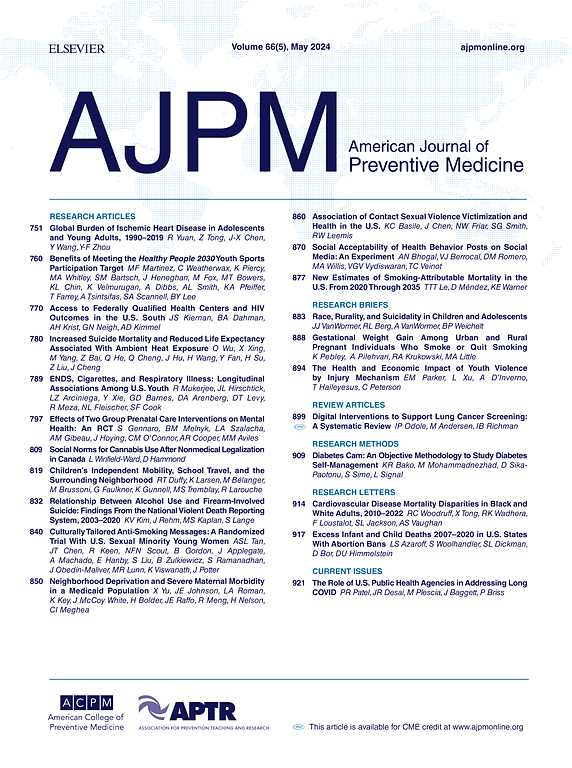枪支暴力的集中富裕和剥夺与空间分布:美国城市社区的种族/民族差异
IF 4.5
2区 医学
Q1 MEDICINE, GENERAL & INTERNAL
引用次数: 0
摘要
前言:本研究考察了社区水平上相对富裕的剥夺是否与枪击事件的空间变化有关,以及这种联系是否因社区的种族/民族构成而不同。方法:从美国暴力数据库中获取2020年至2023年美国100个城市的区域级枪支暴力数据。一种现代的收入不平等衡量标准——极端集中指数和负二项回归模型被用来估计极端集中对黑人、西班牙裔、混合少数民族、白人和种族融合社区枪击事件的边际影响。数据分析在2024年12月至2025年7月期间进行。结果:边际效应的比较显示,在黑人和混合少数族裔社区,极端集中对枪支暴力的影响明显大于以西班牙裔或白人为主的社区。结论:本研究突出了收入不平等在不同人口分布的社区中的差异影响。富裕和贫困的集中对黑人和混合少数族裔社区的枪支暴力负担有更明显的影响。基于地点的干预措施,包括对低收入黑人和混合少数族裔社区的投资,可能是预防枪支暴力的有希望的工具。本文章由计算机程序翻译,如有差异,请以英文原文为准。
Concentrated Affluence and Deprivation and Spatial Distribution of Firearm Violence: Racial/Ethnic Disparities Across Urban Neighborhoods in the U.S.
Introduction
This study examined whether neighborhood-level concentration of deprivation relative to affluence is associated with spatial variation in shootings and whether this association differs by the racial/ethnic composition of neighborhoods.
Methods
Tract-level firearm violence data from 2020 to 2023 were obtained for 100 U.S. cities from the American Violence database. A modern measure of income inequality—Index of Concentration at the Extremes—and negative binomial regression models were used to estimate the marginal effects of concentration at the extremes on shootings across Black, Hispanic, mixed minority, White, and racially integrated neighborhoods. Data analysis was conducted between December 2024 and July 2025.
Results
A comparison of marginal effects revealed that the impact of concentration at the extremes on firearm violence was significantly greater in Black and mixed-minority neighborhoods than in predominantly Hispanic or White neighborhoods.
Conclusions
This study highlights the differential effects of income inequality across neighborhoods with varied population profiles. The concentration of affluence and deprivation has more pronounced effects on the burden of firearm violence in Black and mixed minority neighborhoods. Place-based interventions including investments in low-income Black and mix minority neighborhoods might be promising tools for firearm violence prevention.
求助全文
通过发布文献求助,成功后即可免费获取论文全文。
去求助
来源期刊

American Journal of Preventive Medicine
医学-公共卫生、环境卫生与职业卫生
CiteScore
8.60
自引率
1.80%
发文量
395
审稿时长
32 days
期刊介绍:
The American Journal of Preventive Medicine is the official journal of the American College of Preventive Medicine and the Association for Prevention Teaching and Research. It publishes articles in the areas of prevention research, teaching, practice and policy. Original research is published on interventions aimed at the prevention of chronic and acute disease and the promotion of individual and community health.
Of particular emphasis are papers that address the primary and secondary prevention of important clinical, behavioral and public health issues such as injury and violence, infectious disease, women''s health, smoking, sedentary behaviors and physical activity, nutrition, diabetes, obesity, and substance use disorders. Papers also address educational initiatives aimed at improving the ability of health professionals to provide effective clinical prevention and public health services. Papers on health services research pertinent to prevention and public health are also published. The journal also publishes official policy statements from the two co-sponsoring organizations, review articles, media reviews, and editorials. Finally, the journal periodically publishes supplements and special theme issues devoted to areas of current interest to the prevention community.
 求助内容:
求助内容: 应助结果提醒方式:
应助结果提醒方式:


